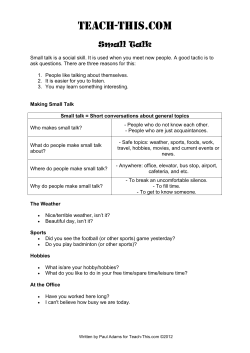
Tibial stress syndrome (shin splints)
UK HealthCare Sports Medicine Patient Education March 10 Tibial stress syndrome (shin splints) Description Shin splints is a term broadly used to describe pain in the lower extremity brought on by exercise or athletic activity. Most commonly it refers to medial tibial stress or periostitis. Periostitis is inflammation of the lining of the bone (periosteum). Common signs and symptoms Pain in the front or more commonly the inner part of the lower half of the shin (lower leg), above the ankle Pain that initially occurs after exercise, progressing to pain in the beginning of exercise that lessens after a short warm-up period With continued exercise and left untreated, constant pain that eventually causes the athlete to stop sports participation Causes Overuse from repetitive activity, which leads to breakdown of the tissues Re-injury from continued activity – not allowing the breakdown of tissues to be repaired. This breakdown exceeds the ability of the tendon and periosteum to heal completely, resulting in increased inflammation and pain Risk increases with: Weakness or imbalance of the muscles of the leg and calf Poor physical conditioning (strength and flexibility) Inadequate warm-up and stretching before practice or play Sports that require repetitive loading or running, such as marathon running, soccer, walking and jogging, particularly on uneven terrain or hard surfaces (concrete) Lack of conditioning early in the season or practice Poor running technique Flat feet Sudden change in activity level, distance, or intensity Initial treatment Initial treatment consists of medications and ice to relieve pain; stretching and strengthening exercises of the foot, ankle and leg; rest; and modification of the activity that initially caused the problem. These can all be carried out at home for acute cases, although referral to a physical therapist or athletic trainer for further evaluation and treatment may be recommended. Call 859‐323‐5533 or 1‐800‐333‐8874 Page 1 of 3 UK HealthCare Sports Medicine Patient Education March 10 Arch supports (orthotics) for those with flat feet may also be indicated. Occasionally, taping or bracing the leg may be recommended. Gradual return to activity is allowed after symptoms are resolved. Rarely, surgery is attempted to remove the chronically inflamed tissue. Medication Nonsteroidal anti-inflammatory medications such as aspirin and ibuprofen (do not take within 7 days before surgery), or other minor pain relievers such as acetaminophen, are often recommended. Take these as directed by your physician. Contact your physician immediately if any bleeding, stomach upset, or signs of an allergic reaction occur. Topical ointments may be of benefit. Pain relievers may be prescribed as necessary by your physician. Use only as directed and only as much as you need. Heat and cold Cold is used to relieve pain and reduce inflammation for acute and chronic cases. Cold should be applied for 10 to 15 minutes every 2 to 3 hours for inflammation and pain and immediately after any activity that aggravates your symptoms. Use ice packs or an ice massage. Cold should be applied for the first 72 hours after initial injury. Heat may be used before performing stretching and strengthening activities prescribed by your physician, physical therapist or athletic trainer. Use a heat pack or a warm soak. Do not use heat if inflammation (swelling) is present. Lower leg stretching and exercises Achilles: Stand with involved leg back. Keep heel on floor and gently lean forward until feel stretch and hold that position. Stretch should be performed with knee straight, then with knee bent. Each stretch should be held for 25-30 seconds. Resisted ankle exercise: With resistance around your toes and with the tubing anchored, pull foot opposite of the Call 859‐323‐5533 or 1‐800‐333‐8874 Page 2 of 3 UK HealthCare Sports Medicine Patient Education March 10 resistance as illustrated below. Return slowly to starting position, and then repeat exercise 20 times. Do this exercise 3 sessions per day. Call 859‐323‐5533 or 1‐800‐333‐8874 Page 3 of 3
© Copyright 2025





















